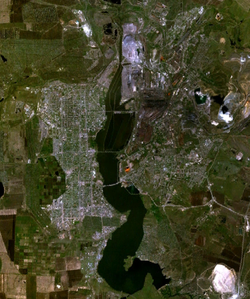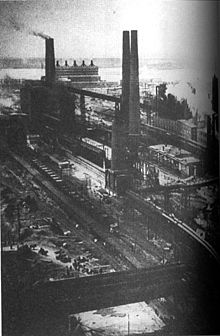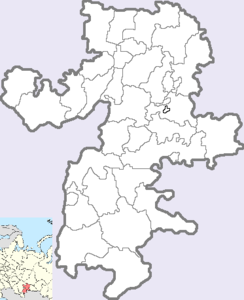- Magnitogorsk
-
Magnitogorsk (English)
Магнитогорск (Russian)- City[citation needed] - 
Satellite imageCoordinates: 53°23′N 59°02′E / 53.383°N 59.033°ECoordinates: 53°23′N 59°02′E / 53.383°N 59.033°E Coat of arms Flag Administrative status Country Russia Federal subject Chelyabinsk Oblast Municipal status Urban okrug Magnitogorsky Urban Okrug[citation needed] Administrative center of Magnitogorsky Urban Okrug[citation needed] Mayor[citation needed] Yevgeny Teftelev[citation needed] Representative body City Duma[citation needed] Statistics Population (2010 Census,
preliminary)408,401 inhabitants[1] - Rank in 2010 44th Population (2002 Census) 418,545 inhabitants[2] - Rank in 2002 43rd Time zone YEKST (UTC+06:00)[3] Founded 1743[citation needed] Postal code(s) 455000[citation needed] Dialing code(s) +7 3519[citation needed] Official website Magnitogorsk (Russian: Магнитогóрск, roughly translated as magnet-mountain city) is a mining and industrial city in Chelyabinsk Oblast, Russia, located on the eastern (Siberian) side of the extreme southern extent of the Ural Mountains by the Ural River. Population: 408,401 (2010 Census preliminary results);[1] 418,545 (2002 Census);[2] 440,321 (1989 Census).[4]
It was named for the Magnitnaya Mountain that was almost pure iron, a geological anomaly. It is the second largest city in Russia which does not serve as an administrative center of either a federal subject or an administrative division. The largest iron and steel works in the country, Magnitogorsk Iron and Steel Works, is located here.
Contents
History
'Magnitnaya' was founded in 1743 as part of the 'Orenburg Line' of forts. It remained insignificant until about 1929.
The rapid development of Magnitogorsk stood at the forefront of Joseph Stalin's Five-Year Plans in the 1930s. It was a showpiece of Soviet achievement. Huge reserves of iron ore in the area made it a prime location to build a steel plant capable of challenging its Western rivals. However, a large proportion of the workforce, as ex-peasants, typically had few industrial skills and little industrial experience. To solve these issues, several hundred foreign specialists arrived to direct the work, including a team of architects headed by the German Ernst May.
 A steel production facility in Magnitogorsk in the 1930s
A steel production facility in Magnitogorsk in the 1930s
According to original plans Magnitogorsk was to be inspired by Gary, Indiana and Pittsburgh, Pennsylvania, at the time the most prominent centers of steel production in the United States. It was to have followed the linear city design, with rows of similar superblock neighborhoods running parallel to the factory, with a strip of greenery, or greenbelt, separating them. Planners would align living and production spheres so as to minimize necessary travel time: workers would generally live in a sector of the residential band closest to the sector of the industrial band in which they worked.
However, by the time that May completed his plans for Magnitogorsk construction of both factory and housing had already started. The sprawling factory and enormous cleansing lakes had left little room available for development, and May, therefore, had to redesign his settlement to fit the modified site. This modification resulted in a city being more "rope-like" than linear. Although the industrial area is concentrated on the left bank of the river Ural, and the most residential complexes are separated and located on its right bank, the city inhabitants are still subjected to noxious fumes and factory smoke.
Town status was granted to Magnitogorsk in 1931.
In 1937 foreigners were told to exit and Magnitogorsk was declared a Closed city. There is not much reliable information about events and development of the city during the closed period.
The city played an important role during World War II because it supplied much of the steel for the Soviet war machine and its strategic location near the Ural Mountains meant Magnitogorsk was safe from seizure by the German Army.
Later years
During perestroika the closed city status was removed and foreigners were allowed to visit the city again. Years after perestroika brought a significant change in the life of the city, the Iron and Steel Plant was reorganized as a joint-stock company Magnitogorsk Iron and Steel Works (MISW or MMK), which helped with the reconstruction of the railway and building a new airport.
With the depletion of the substantial local iron-ore reserves, Magnitogorsk has to import raw materials from Sokolvsko-Sarbaisky deposit in northern Kazakhstan.[citation needed]
Transport
The city is connected by the Magnitogorsk International Airport, and by railway. Public transport includes trams, buses and taxi.
Education and culture
There are three establishments of higher education in Magnitogorsk: Magnitogorsk State Technical University (MSTU), Magnitogorsk State University (MaSU), and Magnitogorsk State Conservatory (MSC). There are also three theatres: Pushkin Drama Theatre (the oldest in the city), the Opera and Ballet House, and the Puppet Theatre.
Sports
Metallurg Magnitogorsk is an ice hockey team based in Magnitogorsk, playing in the Kontinental Hockey League. Evgeni Malkin of the Pittsburgh Penguins and Nikolai Kulemin of the Toronto Maple Leafs both used to play for the club and both are Magnitogorsk natives. The town's football team is FC Magnitogorsk playing in the Amateur Football League. Located in the vicinity of the city, Abzakovo is a popular mountain skiing base built by the MMK (see the URL below).
Ecology
Magnitogorsk was mentioned in the Blacksmith Institute's 2006 survey of the world's worst polluted cities, placed in the report's unranked list of the 25 most polluted places outside the top ten. Pollutants include lead, sulfur dioxide, heavy metals and other air pollutants. According to the local hospital, only 1% of all children living in the city are in good health. The Blacksmith Institute says that, according to a local newspaper report, "only 28% of infants born in 1992 were healthy, and only 27% had healthy mothers."[5]
Bibliography
- Scott, John, Behind the Urals: An American Worker in Russia's City of Steel, Indiana University Press, 1989. ISBN 0-253-20536-0
- Degtyarev A. G., Letopis' gory Magnitnoy i goroda Magnitogorska, 1993.
The book is about Magnitogorsk, its history and natural resources
- Stephen Kotkin. Steeltown, USSR
References
- ^ a b Федеральная служба государственной статистики (Federal State Statistics Service) (2011). "Предварительные итоги Всероссийской переписи населения 2010 года (Preliminary results of the 2010 All-Russian Population Census)" (in Russian). Всероссийская перепись населения 2010 года (All-Russia Population Census of 2010). Federal State Statistics Service. http://www.perepis-2010.ru/results_of_the_census/results-inform.php. Retrieved 2011-04-25.
- ^ a b Федеральная служба государственной статистики (Federal State Statistics Service) (2004-05-21). "Численность населения России, субъектов Российской Федерации в составе федеральных округов, районов, городских поселений, сельских населённых пунктов – районных центров и сельских населённых пунктов с населением 3 тысячи и более человек (Population of Russia, its federal districts, federal subjects, districts, urban localities, rural localities—administrative centers, and rural localities with population of over 3,000)" (in Russian). Всероссийская перепись населения 2002 года (All-Russia Population Census of 2002). Federal State Statistics Service. http://www.perepis2002.ru/ct/doc/1_TOM_01_04.xls. Retrieved 2010-03-23.
- ^ Правительство Российской Федерации. Постановление №725 от 31 августа 2011 г. «О составе территорий, образующих каждую часовую зону, и порядке исчисления времени в часовых зонах, а также о признании утратившими силу отдельных Постановлений Правительства Российской Федерации». Вступил в силу по истечении 7 дней после дня официального опубликования. Опубликован: "Российская Газета", №197, 6 сентября 2011 г. (Government of the Russian Federation. Resolution #725 of August 31, 2011 On the Composition of the Territories Included into Each Time Zone and on the Procedures of Timekeeping in the Time Zones, as Well as on Abrogation of Several Resolutions of the Government of the Russian Federation. Effective as of after 7 days following the day of the official publication).
- ^ "Всесоюзная перепись населения 1989 г. Численность наличного населения союзных и автономных республик, автономных областей и округов, краёв, областей, районов, городских поселений и сёл-райцентров. (All Union Population Census of 1989. Present population of union and autonomous republics, autonomous oblasts and okrugs, krais, oblasts, districts, urban settlements, and villages serving as district administrative centers.)" (in Russian). Всесоюзная перепись населения 1989 года (All-Union Population Census of 1989). Demoscope Weekly (website of the Institute of Demographics of the State University—Higher School of Economics. 1989. http://demoscope.ru/weekly/ssp/rus89_reg.php. Retrieved 2010-03-23.
- ^ The World's Worst Polluted Places: The Top Ten, Blacksmith Institute, September 2006
External links
- http://magnitka.clink.ru the official website of Magnitogorsk
- City Magnitogorsk (Russian)
- http://macalester.edu/courses/geog61/aritz/magnitogorsk.html Macalester College site about Magnitogorsk
- Magnitogorsk and Vicinity (Abzakovo, Bannoye)
- The Soviet Steel City at Magnitogorsk
- Magnitogorsk Photos
Administrative divisions of Chelyabinsk Oblast 
Cities and towns Asha · Bakal · Chebarkul · Karabash · Kartaly · Kasli · Katav-Ivanovsk · Kopeysk · Korkino · Kusa · Kyshtym · Magnitogorsk · Miass · Minyar · Nyazepetrovsk · Ozyorsk · Plast · Satka · Sim · Snezhinsk · Troitsk · Tryokhgorny · Ust-Katav · Verkhneuralsk · Verkhny Ufaley · Yemanzhelinsk · Yuryuzan · Yuzhnouralsk · Zlatoust
Districts Agapovsky · Argayashsky · Ashinsky · Bredinsky · Chebarkulsky · Chesmensky · Kartalinsky · Kaslinsky · Katav-Ivanovsky · Kizilsky · Korkinsky · Krasnoarmeysky · Kunashaksky · Kusinsky · Nagaybaksky · Nyazepetrovsky · Oktyabrsky · Plastovsky · Satkinsky · Sosnovsky · Troitsky · Uvelsky · Uysky · Varnensky · Verkhneuralsky · Yemanzhelinsky · YetkulskyCategories:- Cities and towns in Chelyabinsk Oblast
- Cities and towns built in the Soviet Union
- Socialist planned cities
Wikimedia Foundation. 2010.



